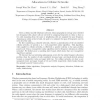Free Online Productivity Tools
i2Speak
i2Symbol
i2OCR
iTex2Img
iWeb2Print
iWeb2Shot
i2Type
iPdf2Split
iPdf2Merge
i2Bopomofo
i2Arabic
i2Style
i2Image
i2PDF
iLatex2Rtf
Sci2ools
ALGORITHMICA
2010
2010
Absolute and Asymptotic Bounds for Online Frequency Allocation in Cellular Networks
Given a cellular (mobile telephone) network, whose geographical coverage area is divided into hexagonal cells, phone calls are serviced by assigning frequencies to them so that no two calls emanating from the same or neighboring cells are assigned the same frequency. Assuming an online arrival of calls, the goal is to minimize the span of frequencies used to serve all of the calls. By first considering -colorable networks, which is a generalization of the (3-colorable) cellular networks, we present a ( + 1)/2-competitive online algorithm. This algorithm, when applied to cellular networks, is effectively a positive solution to the open problem posed in [3]: Does a 2-competitive online algorithm exist for frequency allocation in cellular networks? We further prove a matching lower bound, which shows that our 2-competitive algorithm is optimal. We discover that an interesting phenomenon occurs for the online frequency allocation problem when the number of calls considered becomes large: ...
| Added | 08 Dec 2010 |
| Updated | 08 Dec 2010 |
| Type | Journal |
| Year | 2010 |
| Where | ALGORITHMICA |
| Authors | Joseph Wun-Tat Chan, Francis Y. L. Chin, Deshi Ye, Yong Zhang |
Comments (0)

